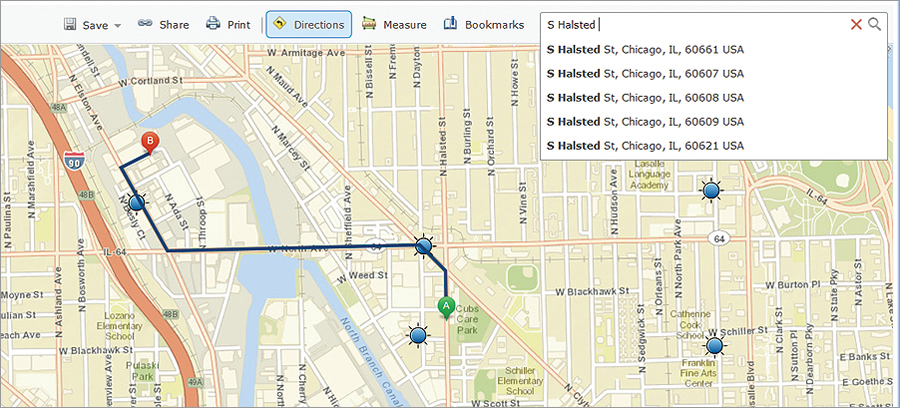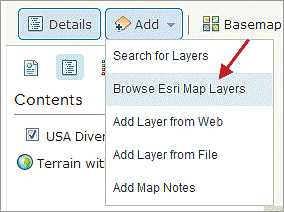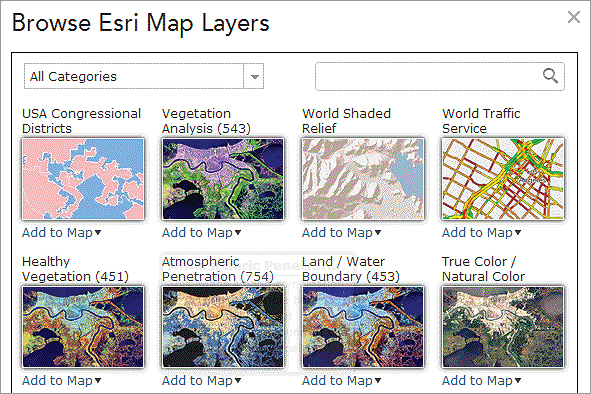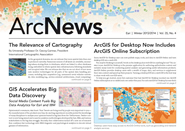The September update to ArcGIS Online included changes and enhancements to the map viewer and application templates and improvements for configuring enterprise logins. ArcGIS Online basemaps were also updated with many contributions from the Community Maps Program. Also, ArcGIS Online is now included with ArcGIS for Desktop (see “ArcGIS for Desktop Now Includes ArcGIS Online Subscription“).

Map Viewer
We’ve improved how you can access and add Esri Map Layers to your maps. You can now access a gallery of Esri Map Layers directly from the Add button in the map viewer. Esri Map Layers include imagery and layers about people (demographics and lifestyle), earth (land cover, soils, elevation), and life (ecology, species biology, ecosystem). You can drag and drop layers to reorder your map content. If your map includes a layer that could be updated while the map is open (for example, when your field crew is collecting data), you can now set a refresh interval for the layer. This will keep your map in sync with the latest data, even while your map is open in a browser, on the desktop, or web or mobile apps. We also improved the Find address or place locator. Now, as you type in your search terms, you get a list of suggestions that you can choose from.
Web Application Templates
With this updated Map Tour template, you can now incorporate videos (existing and new Map Tours). An interactive builder guides you through adding videos hosted on YouTube and Vimeo (and other sources). In the Storytelling Swipe template, you can include a scene navigation tool that takes users to a specific location and displays notes. We retired a number of templates from the web app gallery: Compare Maps, Search Maps, Side-by-Side Viewer, Storytelling Tabbed, and Twitter Timeline. However, these templates are still available as items in ArcGIS Online that you can find and download using Search.
Geocomments created by the web scene author in the Esri CityEngine Web Viewer that are symbolized differently can now be displayed independently of other comments. You will see faster performance when working with scenes that contain many features.

Ready-to-Use Layers and Tools
Forty new landscape layers are available. These layers focus on critical habitat, species range, and soils. There are also new dynamic layers for hazardous waste, aquifers, and coalfields. In total, there are now more than sixty Esri landscape layers available for the United States that you can use with your maps and as input to your geoprocessing models. They cover a wide range of uses, from biogeographic analysis and natural resource management to land use and conservation planning. While these layers are still in beta, anyone with an ArcGIS Online subscription can access them.
Performance has been improved for service area analysis with overlapping polygons and the traffic map display. The closest facility and service area output results include additional attribute information from input features.
ArcGIS Online Account Administration
ArcGIS Online Help includes steps for configuring OpenAM 10.1.0 and NetIQ Access Manager 3.2 as enterprise providers. We’ve improved the design for configuring the organization description field. You have a View HTML Source option to more easily create a description with HTML.
Other Enhancements
When you add an image file to ArcGIS Online and share it publicly, the details page displays the URL of the image. You can use the URL to reference the image in web apps, web map pop-up windows, and so on.
Two new language options have been added to ArcGIS Online: Czech and Finnish, for a total of 24 languages. Setting your language determines the user interface as well as the way time, date, and numerical values appear.

ArcGIS Online Basemap Updates
World Imagery Map—In mid-October, we released the fifth significant update of DigitalGlobe imagery in the World Imagery Map. More than 30 terabytes of new and updated high-resolution imagery, covering nearly 45 million square miles (about 115 million square kilometers) at a scale down to 4,000, have been added to the World Imagery Map. Much of this release fills in areas between major metropolitan centers, but cities such as Osaka, Japan; La Paz, Bolivia; and Bamako, Mali, display high-resolution imagery. In addition, some areas were updated with more recent imagery, including Christchurch, New Zealand; Phnom Penh, Cambodia; and Izmir, Turkey. We also received a number of new contributions and updates from the Community Maps Program. Some of the new contributions at 36,000 to 1,000 scale include the Kingdom of Denmark; Leon County, Florida; City of Riverside, California; Tompkins County, New York; and Central Vermont, USA, at 36,000 to 2,000 scale. Updated imagery includes the countries of Singapore (36,000 to 4,000 scale) and Suriname (36,000 to 1,000 scale).
World Topographic Map—New and updated content received through the Community Maps Program was added to the World Topographic Map. New content for the United States includes El Paso County, Texas; Lewis & Clark County, Montana; Las Vegas, Nevada; Kittitas County, Washington; University of Wyoming, Wyoming; and University of Tuskegee, Alabama. Updated content for the United States includes Collier County, Florida; Denver County, Colorado; El Paso County, Texas; Peoria County, Illinois; Chandler, Arizona; York, Maine; Greater Portland, Oregon; and Tacoma, Washington. We’ve also added new and updated content for Canada at 9,000 to 1,000 scale for 68 communities, including municipalities, cities, towns, universities, and colleges. Comprehensive updates for the countries of the Czech Republic, the Netherlands, and France were also added. The data for the update to France came from best available authoritative sources, including IGN BD ADRESSE and IGN BD TOPO, as well as HERE and INTERMAP. Updated content for Australia and New Zealand was published in World Topographic, World Street, and Light Gray Canvas basemaps, as well as in World Transportation and World Boundaries and Places reference overlays. We continue to update and expand our global large-scale basemap coverage from 288,000 to 4,000 nationwide in the United States and to 2,000 and 1,000 in select areas.
For a complete list of all contributions to each of the world basemaps, visit esriurl.com/contributors.
Related Podcast
ArcGIS Online and Focused App Creation
Jeremy Weber from GEO-Jobe GIS Consulting talks about implementing ArcGIS Online in state and local governments and airports. Listen to the podcast. [09:00 | 8 MB]

